

 |
 |
Have you ever heard of the Zodiacal Light?, most people haven't however if you are an amateur astronomer then you most likely will have but how many of you have actually seen it? my intention with this image report is to showcase my own visual observations and images from my last night sky shoot with the hope that I can shed some light on the Zodiacal Light (ZL) for those who want to tick the phenomena off their wish list. Astronomers now believe our solar system is approximately 4.5 billion years old, after the sun ignited as a thermonuclear reactor it soon formed an accretion disk of material which would later cool and condense in that planets, asteroids and comets which we see today. Over billions of years this debris disk was constantly replenished by tiny ice and dust particles from visiting comets. This disk of dust is literally the left over material from the formation of our solar system which circumvents the sun, the sun, moon and planets all reside within this plane, astronomers call this the ecliptic plane, this is simply a fancy way to describe the path of the moon and planets projected onto the night sky as an imaginary line as seen from Earh. The constellations through which the ecliptic passes are known as the Zodiacal constellations and hence where we will find the Zodiacal Light.
The ZL is best seen during the pre-dawn sky in Autumn and in the corresponding evening sky during Spring. These seasons are particularly fruitful for ZL hunters because the ecliptic plane is visible at a steep angle with respect to the horizon, this way the ZL will be best placed for observation due its more prominent stature in the sky. For sky watchers looking to see this elusive glow your best chance of success will be during the more convenient Spring observing window, March and April are prime months. Choose a night free from any moonlight and find a location away from any bright lights, if you have a clear dark sky and a relativity decent horizon then let your eyes adjust to the sky and look to the W just when the sky is getting dark during that special moment between twilight and full astronomical darkness. If you see a glow in this direction or an enhancement to the sky then you have just witnessed the ZL. If you are not sure and to be more specific, does that glow look like a wedge or even a slanted pyramid?, the ZL tends to have a broad base where it emerges from the horizon then becomes more slender with altitude, it may even appear to taper to an ill-defined point. The ZL is part of a much larger atmospheric system called the ZL complex, in this system the ZL in the evening sky merges into the Zodiacal Band which meets the Gegenschein (counter glow) then connects with the ZL in the pre-dawn sky however in this report we will be focusing exclusively on the ZL evening sky apparition.
I have observed the ZL periodically over the years and have come to know it as a much welcomed friend, on some occasions I have actively seaked out the phenomena yet on other occasions I have seen it accidentally throughout the course of my observing. The first time I seen the ZL still remains my best sighting to date, during the Autumn of 2003 I was searching for comets before dawn at my old home in Maghera. I noticed the background field within the eyepiece appearing substantially brighter than it should have been for that hour because morning twilight had not appeared yet, it was just too early, I suspected an aurora however there was no such display visible and after all my telescope was facing east. I decided to end my hunt, I walked through the long grass which was covered in dew then made my way into a large pitch, I walked far enough in so that I could see beyond the houses and get an unobstructed view to the horizon. Once I saw it I knew immediately what it was, since my eyes were exceptionally dark adapted from hours of peering through the telescope the phenomena in front of me looked particularly impressive, in fact, it seemed to be jumping out from the sky. I could clearly see a massive triangle of light leaning over and extending upward along the ecliptic like some ghostly form, to me it looked striking and even possessed a subtle green glow which I sometimes detect within the Milky Way, on this particular night the ZL was as bright as the Milky Way within Cygnus and from its top I could see the Zodiacal Band extending beyond the ZL's apex, passing through the Milky Way, then emerging from the other side into the Gegenschein which was visible as a large fuzzy oval low in the western sky. Seeing all three together within the same naked eye field with the Milky Way was an astonishing sight. This was my first introduction to the ZL, if I consulted my log book now I would find my measurements of how many degrees long each side of the ZL was.
Back then digital camera technology was still in its infancy and being able afford the fist entry level DSLRs was out of the question so I never had any way of documenting any future ZL displays, however all that changed during 2010 when I decided to give it a try as back then I made the switch from a bridge camera to my first ever DSLR, the Canon 450D. During that year I decided to attempt to capture the ZL on camera, we had a fine run of dark clear nights with no moon interference so I went for it. I drove up Glenshane Pass and found a derelict road and sure enough the ZL appeared on que, the display was not as vibrant as my first sighting years ago however it was there. Using the 18mm kit lens and ISO of 1600 I successfully managed to capture the ZL, however it was subtle and with a 25 sec exposure it was only visible if one knew where to look, but I was happy to have acquired my first photographic records. I spent five nights in a row returning to that same stretch of road and during one of these nights I was joined by amateur astronomy Andy McCrea who also wanted to see it and sure enough he did, this made for a fine memory indeed. In the years which followed I captured it on camera however it wasn't until 2020 that I decided I wanted to get reacquainted with the ZL since I now had more sensitive equipment. Armed with my new Canon 5D Mark IV and Irix 15mm F/2.4 Blackstone lens I was excited about having a new adventure and communion with the ZL once more.
Amazingly after a period of unsettled weather I got rewarded with a perfectly timed spell of high pressure which would bring cool settled nights, a quick check on the Met Office web site showed that I might even get three clear nights in a row with little to no cloud at all, something which rarer than Hen's teeth in this country. To add to the excitement a new comet had been discovered which was currently much brighter than expected, designated C/2019 Y4 ATLAS, this object was generating much excitement within the astronomical world and if its current rate of brightening was anything to go by there was hope it might become a naked eye object in May, perhaps even a great comet. I had already observed it from my back garden in Maghera however I wanted to see it from a proper dark sky so I decided I would visit Beaghmore Stone Circles in Co. Tyrone for a solo adventure.
There was however a silent killer looming in the form of Covid-19 which had turned into a pandemic and was already starting to affect the UK causing much anxiety. In N. Ireland the reality of the situation and what it meant for our future was beginning to hit home, at the time social distancing was put into effect, we were still aloud to go about our daily lives however we were encouraged to keep a distance of 2m or more from other people and avoid large crowds. Other countries had gone into complete lock down and word was it would come our way soon, perhaps very soon. This naturally affected everyone including myself, deep down I knew it was coming so I decided I would make the most of these clear nights as they could be my last proper photo shoot for some time, so with this mind set every minute with the stars and every breath of fresh air was heavenly.
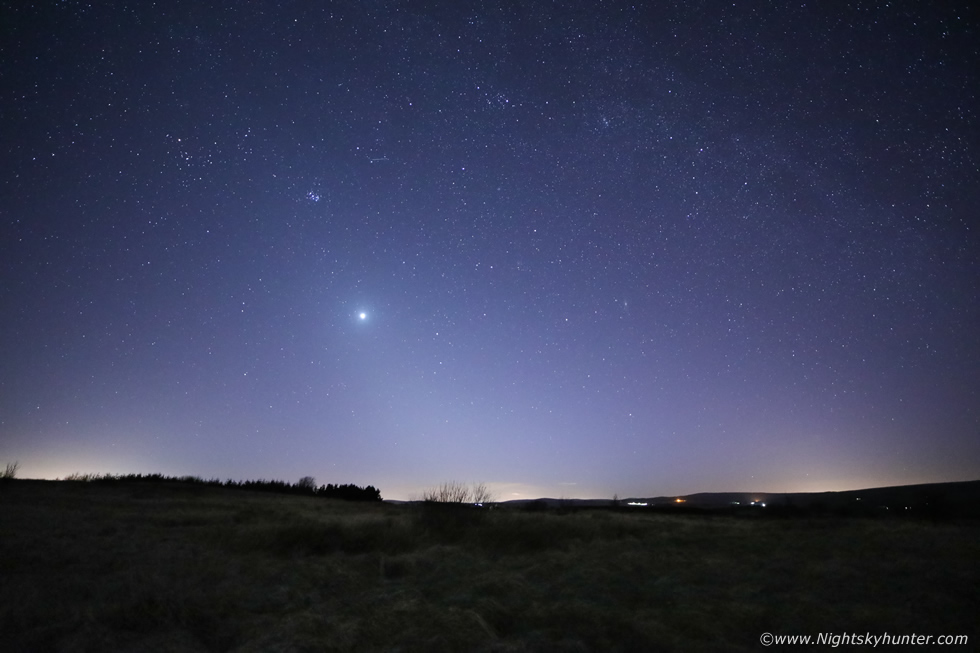 |
I arrived at Beaghmore during evening twilight, I set up my old faithful Meade 8" F/6.3 LX10 S. Cassegrain telescope in the car park and let the trapped thermals inside the tube release into the cool night air, this way when the telescope adjusted to the ambient temperature the stars would appear more steady within the FOV. It was now that perfect transition period between twilight and darkness, a window between two worlds and through that window was the ZL. The light was clearly visible on camera and to the naked eye, in fact, anyone could have seen it if you simply pointed in the appropriate direction, the phenomena looked like a cone of light, broad at the horizon, and more narrow aloft, and as described earlier it followed the path of the ecliptic plane. To prove this mighty planet Venus could be seen embedded within the ZL, I had climbed over the wire fence and was now setting up my camera and tripod on the spongy grass hidden in the darkness, success had been quick this night.
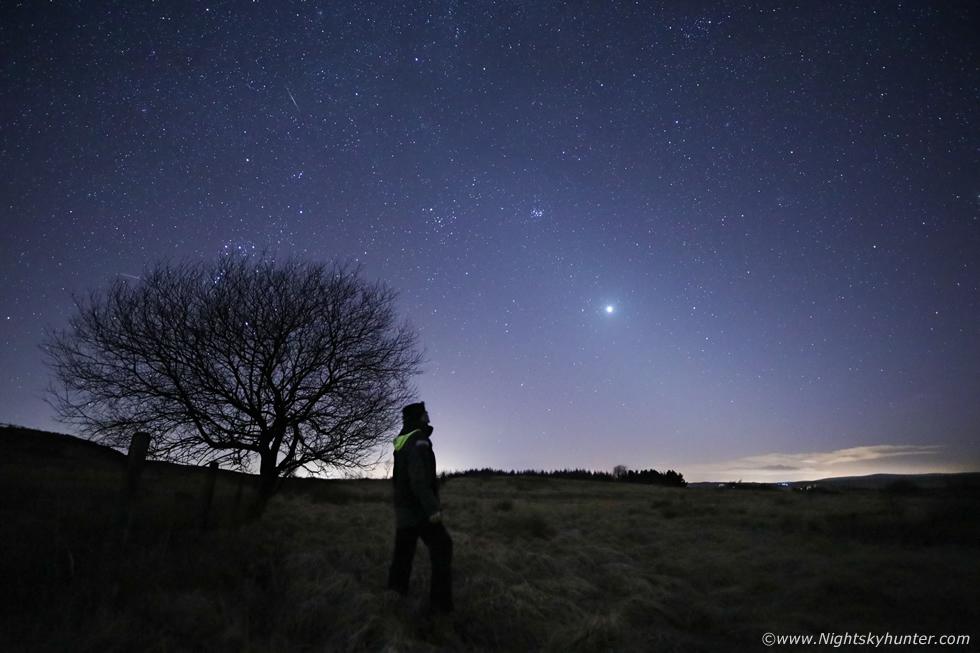 |
I had to do a selfie for the memory and I'm glad I did, in this image you can see the ZL extending beyond Venus and even beyond the Pleiades Cluster (Messier 45), it's apex seemed to diffusely blend in with the Winter Milky Way. F/2.4 for 6 sec's at ISO 12800. Orion's Belt can be seen setting behind the tree top and several satellites on view. I then re-positioned the tripod and shot the first of two ZL time lapses. As the camera worked hard in the darkness I got my eyes dark adapted and got to work with the telescope, it felt great to be observing through this instrument at Beaghmore, this telescope has been by my side for 20 years and I'm still using it, I had christened it DII (Discovery 2) back then, it made me feel happy and content to have DII still in use today, it felt like my older past had now joined me in the modern future. I observed M42 then hunted down M1 the Grab Nebula in Taurus, this was the remnant of an old supernova, I knew if I could locate it then the sky and observer were ready for comet hunting. First of all I guided the scope to the NW and began a careful sweep through a sea of stars in eastern Cassiopeia and found another comet called C/2017 T2 PanSTARRS, the comet looked like a moderately condensed fuzzy haze with bright condensation (DC:6) and elongated in one direction away from the sun which may have been the dust tail captured on recent CCD images.
I then guided the scope to the zenith directly overhead and began searching through Ursa Major within the circumpolar sky. Not far from twin galaxies M81 and M82 I found C/2019 Y4 ATLAS. The comet was large (9 arc min's or more) and very diffuse, difficult to tell where the coma ended and the sky began with a very subtle brightening toward centre, I rated it DC:3. I saw no tail and estimated its brightness at mag +9, I wondered what this insignificant haze in a telescope will look like in late May? At this stage another car arrived, it was a photographer, we chatted briefly then he vanished into the darkness and I was back to telescopic work. Soon after three more cars arrived, I was shocked to see this place so popular, it was evident that others were craving a nature fix and a look at the stars to find some peace and equilibrium. Two girls saw my telescope and came over, we ended up having a great time, I pointed out Venus and the Pleiades, Cassiopeia, Ursa Major and how to use the pointer stars to find Polaris, this was followed by a look at the Orion Nebula in the telescope. One of the girls explained to me she had lost a family member who she lovingly called 'Hunter', I said you won't believe this but my web site is called 'Nightskyhunter', we laughed but at the same time thought it was amazing synchronicity, then she said she always wanted to see the Hunter constellation, I said 'you are looking at it rite now', and Orion was pointed out with his belt and sword, I think seeing Orion and M42 in the scope had made her night, and to be honest it made my night too. Before we parted I took an image of the two girls beside my telescope with Orion visible beside them, I later sent the image through social media so they could have it for their memories. This human connection to the stars made this a very special night for us all. I called it a night at 23.00 UT, it was -1C and my camera battery was low, I packed everything away and headed home, my time lapse turned out nice so the night was a complete success, I was intending to do it all again the following night.
I had spent the day at the north coast during a filming session with the drone then headed back to Cookstown, I needed to get something to eat and changed before nightfall. I got sorted and the forecast looked amazing once more, Roisin was on her way from Belfast so I was waiting on her to arrive, once she did we would head out together for a night under the stars. After gathering a few snacks and topping up with diesel we were on the road and made it to Beaghmore for 20.00 UT. Dungannon photographer John Fagan arranged to meet us for a ZL shoot so it looked like a fun night ahead.
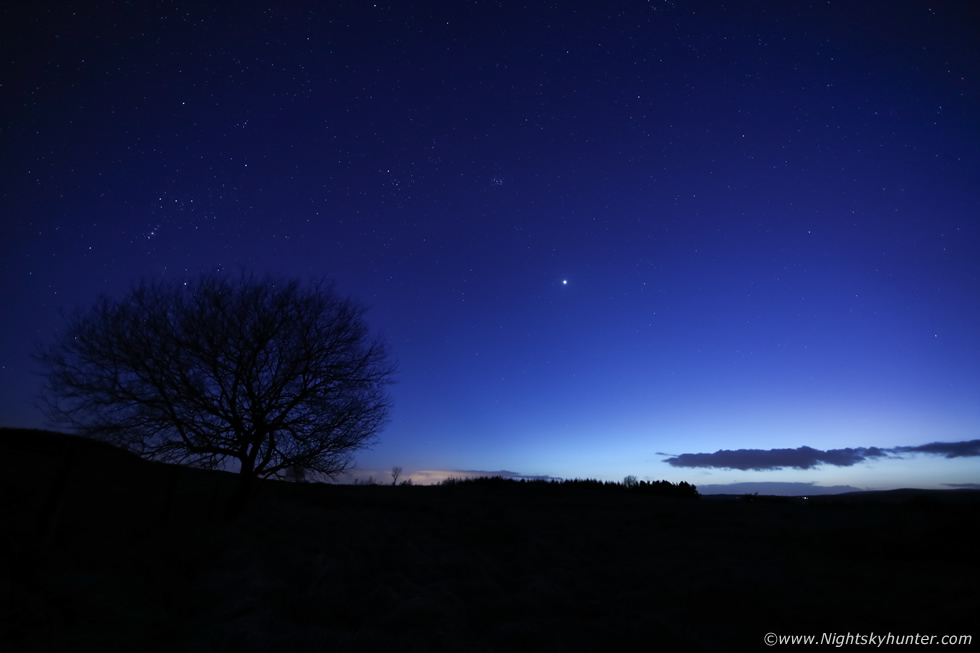 |
Once again I set out DII to cool down and in the meantime Roisin and I adjusted to the darkness and I got my camera ready, we were a little earlier tonight so twilight was still advanced which worked out fine as it gave us a chance to enjoy the sky at a relaxed pace. The twilight was worth an image to document the mood, bright Venus above the twilight arch with Orion above this now familiar tree.
 |
As the sky slowly darkened the ZL appeared, I decided to capture a few memory images for this moment. Roisin used her mobile phone light to illuminate the ground, I asked Roisin to point at Venus, the ZL was clearly visible even though full darkness hadn't arrived yet.
 |
Simple wide field exposure showing everything in the western sky, if you look to the left and right of the ZL you can see how much darker the background sky is. The ZL is an obvious enhancement to the sky in that specific area, in the past observers who saw the glow often mistook it for the rising dawn hence why it's called the Zodiacal Light or 'false dawn'. M31 the Andromeda Galaxy can be seen above the strip of cloud as a fuzzy haze.
 |
A special moment, Roisin and I with the ZL, Venus, Pleiades, Taurus (Roisin's Zodiacal constellation), M31 and the Milky Way. Roisin could see the ZL no problem, as a matter of fact she was able to see it herself when we arrived without any prompting from me. I explained to her that the glow we were looking at was sunlight scattered from dust particles which came from the tails of ancient comets so we were looking at a glow that was billions of years old.
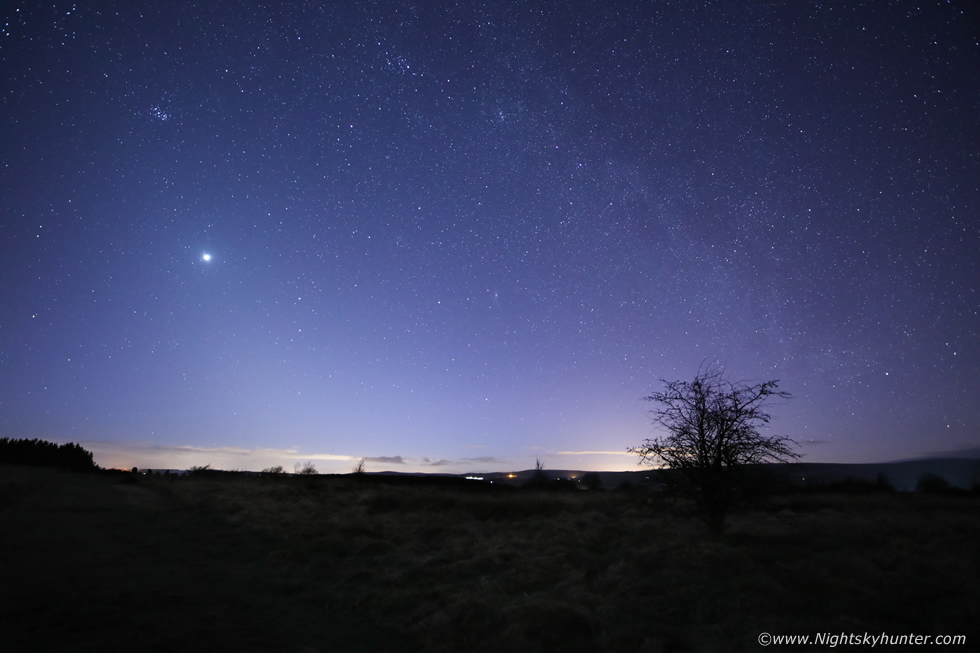 |
John Fagan arrived and a full on shoot began. John shot exposures of the ZL and a time lapse while I began a time lapse too then returned to the telescope. Roisin and I observed M42 and Roisin got to see C/2019 Y4 ATLAS, she understood how a fuzzy glow in a telescope can become a great comet in the future, she was happy to have seen it with her own eyes, we wished the comet well and hoped it would put on a show for us during May. It was at this point that a car pulled up, I paid no attention to the two figures who approached, I just assumed they were out for a walk or getting fresh air, turned out it was the PSNI. They were curious about what we were up to but once they saw the telescope they came over for a chat, the female officer has an interest in astronomy so we ended up having a good time under the stars, they observed the Orion Nebula through the telescope and I did my party piece pointing out Orion, Venus, Cassiopeia and how to find the north star using the Pointer Stars within Ursa Major. We all had a thoroughly pleasant and peaceful time then the officers continued on in the course of their duties, yet another nice encounter with nice people. The above image is one frame from the time lapse showing the Milky Way with dark dust lanes and the double cluster, for these exposures I selected a cool tungsten white balance.
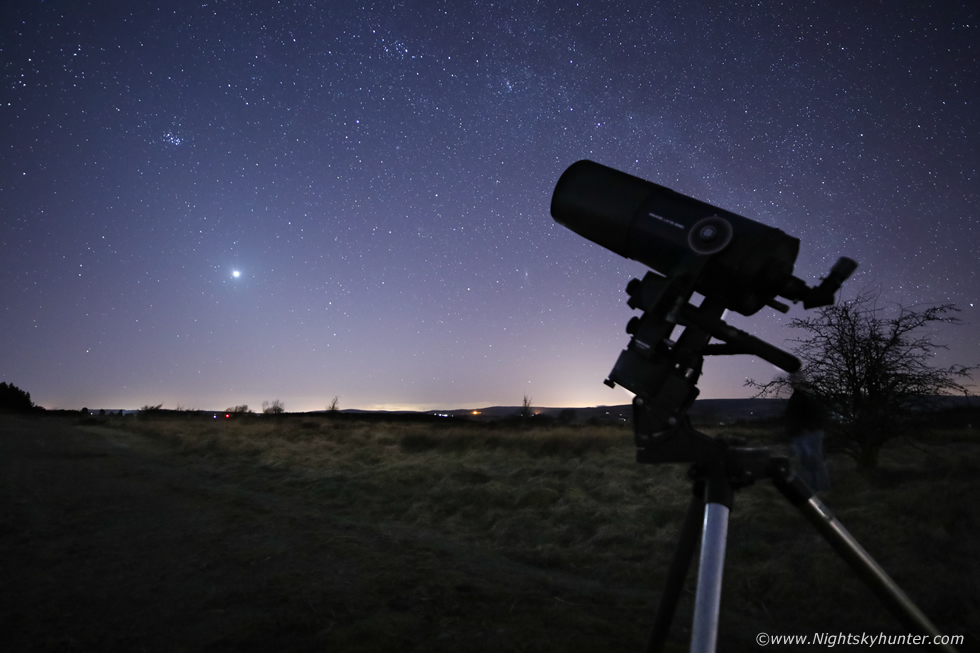 |
I carried DII into the grounds of the stone circles and the telescope made for some interesting foreground against the evening stars. John and Roisin and I where now in the same area chatting away, observing the sky, laughing, and making the most of this gift of a wonderful clear night sky, we couldn't believe getting two clear nights in a row of such high caliber. Can you spot the ZL in this image? your eye should now know what to look for from viewing the previous images. Incidentally my telescope appears to be pointing at variable star Algol or Beta Persei within Perseus, Algol is known as the Demon Star as it changes brightness every couple of days due to one star passing in front of another star, in other words Algol is getting eclipsed by a companion star, this kind of variable star is classified as an 'Eclipsing Binary', on this night Algol was shinning proudly at maximum brightness.
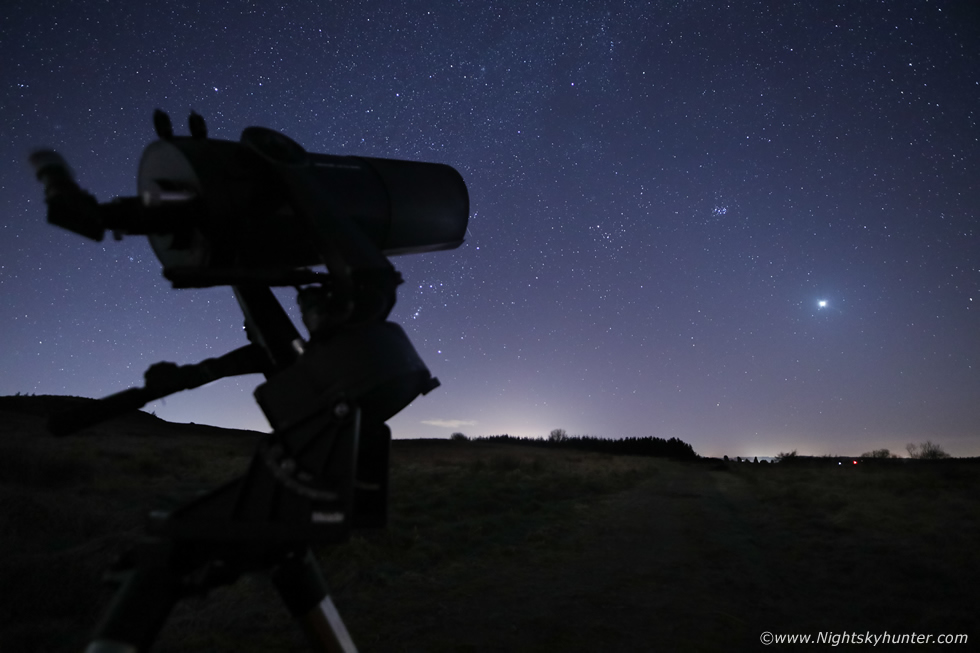 |
In this image DII is pointing at the famous Pleiades star cluster, also known as the Seven Sisters or Messier 45, in early April planet Venus will actually pass through this compact star cluster, what a sight this will be through binoculars or a rich field telescope.
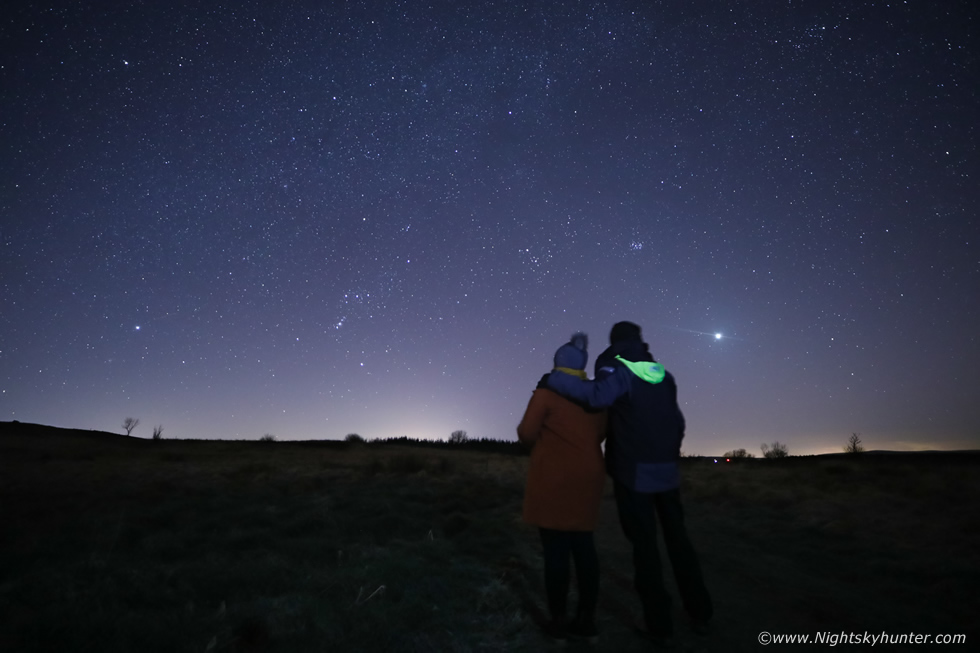 |
Roisin and I admiring Orion while to the left Sirius the Dog Star in Canis Major tries in vain to steal the show, Sirius is the brightest star in the night sky however its brilliance has been in the shadow of Venus. Venus is so bright it can cast shadows on the ground, illuminate objects, and even visible in broad daylight with the naked eye if you know exactly where to look.
 |
From left to right, John Fagan, DII, Roisin McKenna and Martin McKenna, a cherished moment. A new plan was discussed, we knew a lock down would soon be on the way and with the following night also showing clear skies we decided we would do one last photo shoot of the ZL, this time it would be at Ballintoy Harbour on the Co. Antrim coast.
This would be our last clear night before the UK would go into lock down, this would also be our last chance of freedom and to get a proper nature fix. Plans were hastily arranged, John Fagan would meet us at Ballintoy at 20.00, I contacted good friend and photographer Paul Martin who decided that he and his partner Tracy Sharkey would drive up from Omagh later and meet us, this sounded like it was going to be one of those classic nights. Roisin and I went to my Mum's home in Maghera and got shopping for her and made her dinner, then we we hit the road at sunset. Before I left I looked at the satellite images, I was shocked to see a massive band of high level cloud working its away north, it was already covering the entire republic and rapidly nearing the border, I was beginning to think we would not have any clear skies at all, but we decided to take the gamble, after all the north coast was the place mostly likely to hang on to clear skies so we remained committed, we wanted a memory of our last night of freedom and another star fix.
We stopped off in Bushmills for a take away, we ate chicken nuggets from the Causeway car park then watched the sun set over the ocean from the famous Causeway rocks, it was now dusk and the sky was still clear, if it could hold out for another few hours we might just be in luck. We arrived at Ballintoy to a superb sky, there was lingering cloud over the sea lit red from the sun below the horizon, but those few clouds were vanishing as solar heating waned. We had all agreed to meet at Elephant Rock on the west side of Ballintoy, during twilight the walk was tough going because of treacherous ground, sharp stones, holes, hidden hazards, then rickety turnstiles, slippery mud, water logged ground etc, it was slow going but Roisin did a great job and finally we made it to Elephant Rock just as twilight descended and the first stars came out.
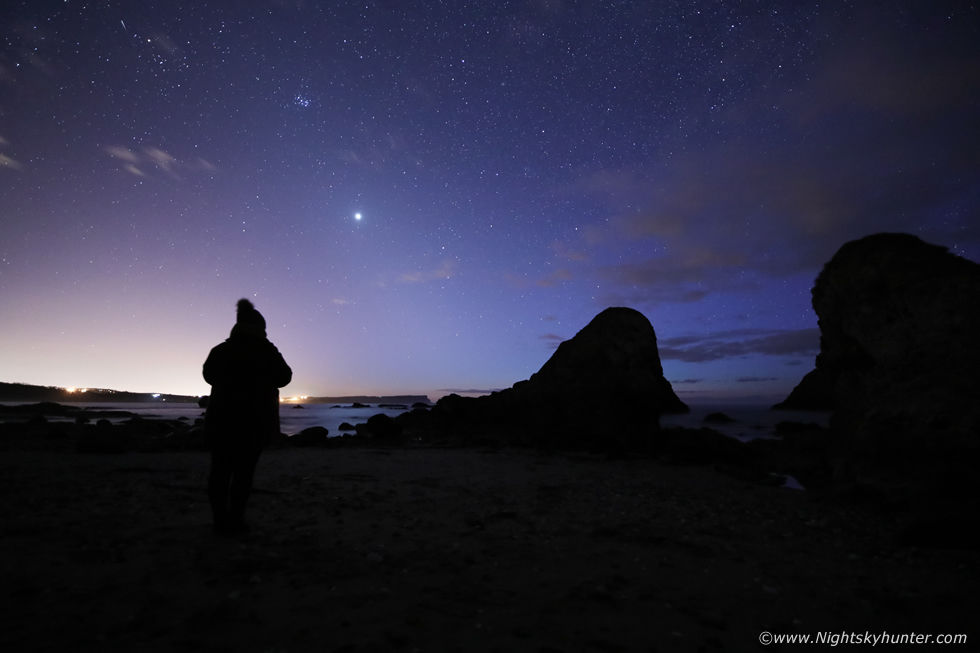 |
This part of the coast is simply amazing, I've had memorable photo shoots here before but it has been quite some time since I had been in this area again under the stars, it looked as good as ever. It was silent except for the stirring of the gentle surf and the periodic call of a nocturnal bird, it was everything we had hoped for, sublime, peaceful, tranquil and clean fresh air. As the ZL appeared I took this exposure of Roisin with Venus, Pleiades and Hyades, with several of the 50 million year old stacks in the frame.
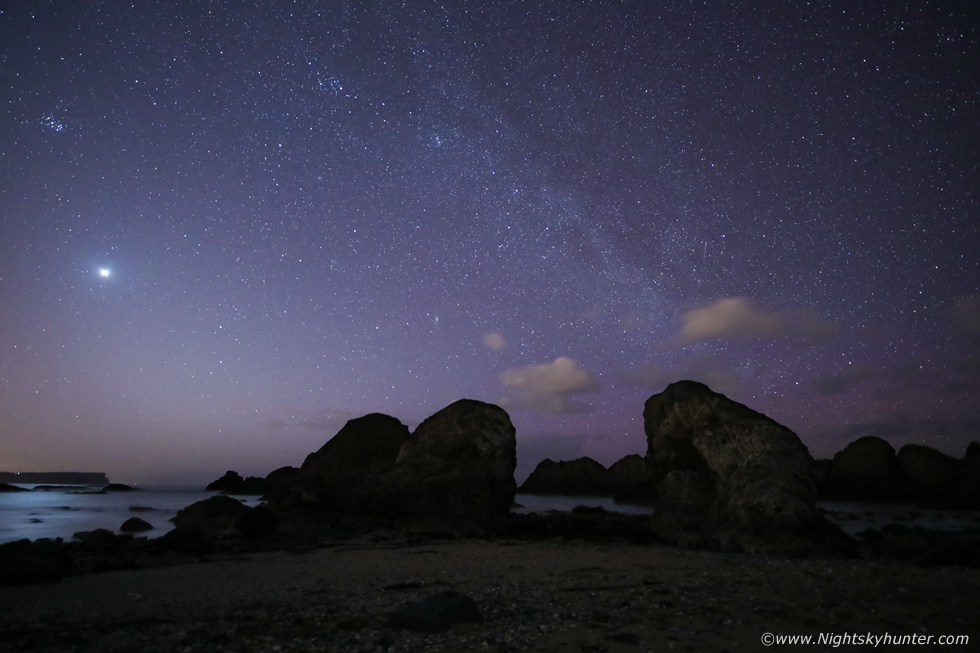 |
John arrived then we began a night of shooting stills and time lapse, I was using the 5D and 15mm and my 600D and 10mm, John also had two cameras set up, one for time lapse and the other for stills. It was that dark here that I literally couldn't see John about 30m away to my right, the only thing that gave away his position was the faint red glow from his camera. I really liked this exposure, F/2.4 at ISO8000 for 14 seconds. ZL on the left, M31 at centre and Milky Way dominating the frame, but wait, what was that to the lower right?, I noticed that the sky was a purple colour in this highly sensitive image, this was the tell tale signature of the aurora. There was a weak solar wind stream tonight however I paid it little heed as I didn't expect anything here but the camera was saying very different. I shut the camera off, got dark adapted and looked due north, sure enough I could see a strange enhancement to the sky, my view was obscured by tall rocks but at one stage I thought I saw a faint beam, I shouted 'aurora' across the darkness to inform John and Roisin, at the time I still didn't trust my instincts but decided to keep an eye on it.
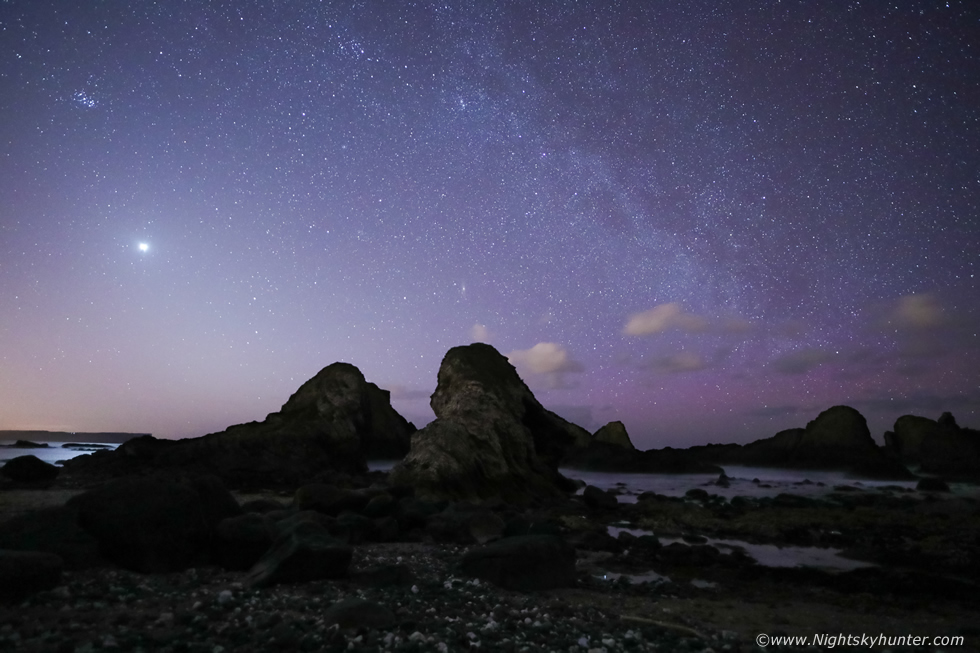 |
Another image using the same settings, this time with an exposure of 16.4 sec's, amazing how much detail the 5D can pick up and how clean the noise is at such high ISOs. The tide was far out this night, the aurora was still showing on my exposures.
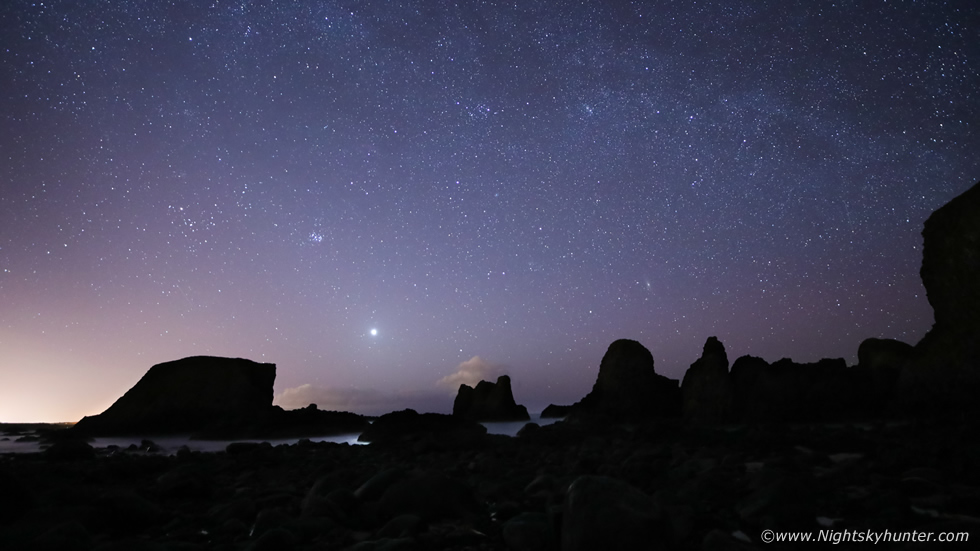 |
Later Roisin and I made our way over to John, close enough to talk while keeping our social distance, we complimented the night sky and chatted about all things sky related, this 16x9 crop was taken in the midst of our conversation at the time. Elephant rock is the larger rock formation on the left, from certain angles it does resemble the head of an elephant. We recalled the amazing night we experienced here during October 7th 2015 when we watched and time lapsed a stunning G2 geomagnetic storm over Elephant Rock which turned the ocean green, make sure to check out the report.
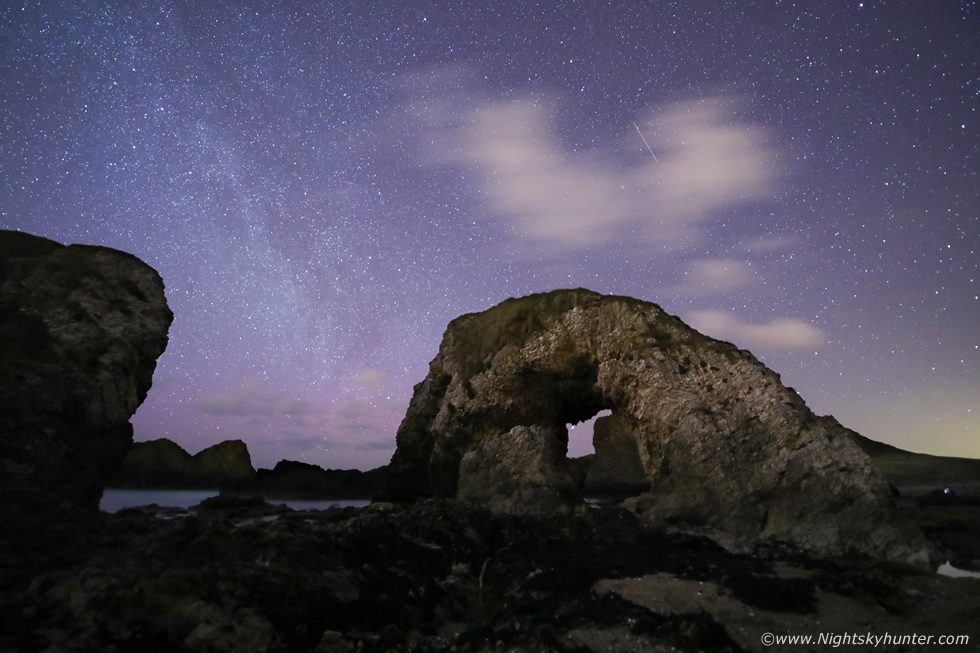 |
I ventured over to the famous arch and shot the Milky Way, ISO 8000 for 27 sec's at F/2.4 with aperture wide open on the Irix 15mm, I have to stay this lens is very sharp wide open on a full frame camera. I would definitely recommend this lens for anyone looking a fast wide angle for full frame at a reasonable price, I could easily have shot this scene at ISO 12800 and the image would still have a good noise control, in fact, the noise at ISO 12800 is much better than ISO 1600 on my crop sensor.
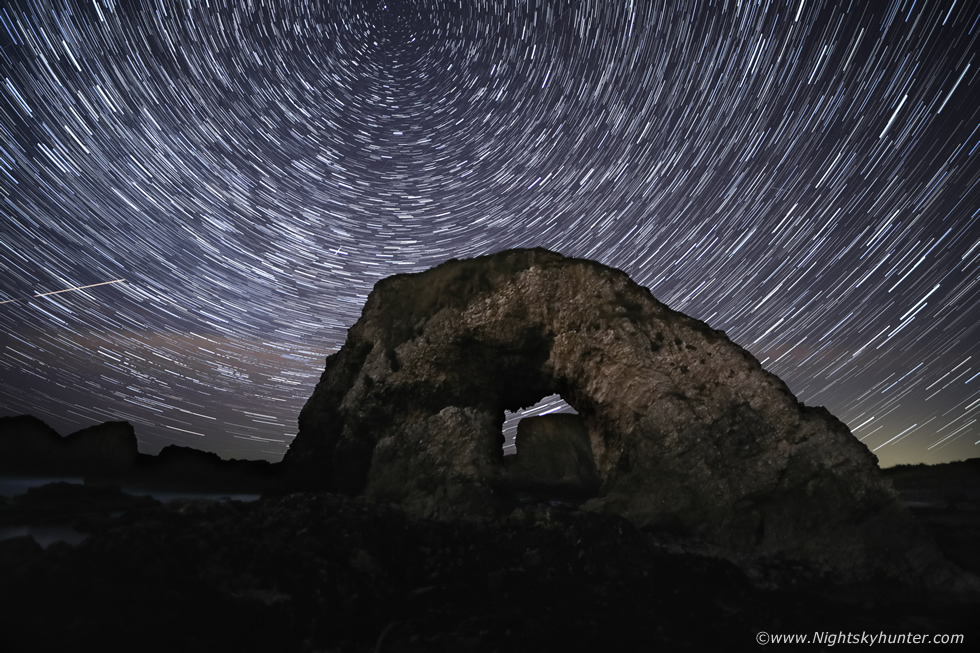 |
The moment was too good to pass so I shot a short time lapse of the Milky Way over the arch, I made this star trail from some of the frames, the lapse turned out great, it was only 5 sec's in duration, now I wish I had let it go for longer, but I will return another time to try it again, I reckon a little moonlight on the rocks would look fantastic. We had been here an hour and a half and so far no word from Paul, I figured he had seen the satellite images and decided not to chance the drive, then my phone rang, it was Paul, he and Tracy where at Ballintoy!, they were on down the trail between us and the car park, this was great news, I was delighted they had made it, so after we finished our images we began the slow walk back along the trail over water and through mud then finally we bumped into Paul and Tracy and their dog Oscar.
 |
This was the first time in a long time since all of us had been together during a shoot, it was a nice moment, Tracy even had a mirrorless camera with her which Paul had got her for Christmas, it was fantastic to see Tracy getting into photography as well. We were all chatting and taking a few test images just for the sake of taking them when suddenly we picked up the aurora again on camera, we couldn't see it visually however there was no question about what it was, Paul and John also detected it on their cameras too, this must have been the upper most portion of a much larger display visible further north. You can see the green and red colours including four or five vertical rays, we were all chuffed, this wasn't a great show by any means, but getting any aurora at all during solar minimum, on a night when you don't expect it and on a night when we are all together this like made for a special treat, it was the icing on the celestial cake, I confidently logged this as my 172nd aurora display, it was a fitting end to a great night.
Time lapse footage from three nights of Zodiacal Light and Venus photography, the first two sequences are from Beaghmore and the third from Ballintoy, you can even see Star Link satellites visible in the upper left at Beaghmore which I didn't notice at the time. A few days after this night lock down was introduced across the UK, this didn't come as a surprise, in fact, we all sensed it in the air, so this was our last proper photo shoot outdoors which made these three nights extra special, they mark a moment in history. As I write this I can't drive out anywhere for photography, I have access to no proper dark skies, my horizon is now hidden by houses, street lights and telegraph poles. How long this lock down lasts is anyone's guess, it could be for weeks or months, in the meantime I'm doing what I can from home, I've been active with DII with observations of Venus and the Moon, and even hunting Venus in daytime, I also hope to keep tracking C/2019 Y4 ATLAS if and when it becomes bright. I will also be updating my web site and social media pages more regularly and have begun making vlogs for my youtube channel which will keep me focused and motivated, I hope you enjoy these. I also hope this will all be over soon and that we will be back out in nature, and most of all, I hope we are all safe and happy, thanks very much for reading.
Martin McKenna